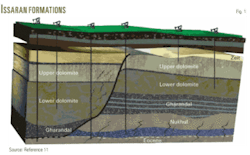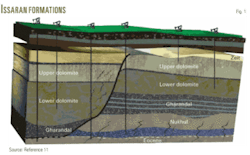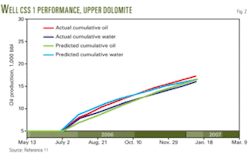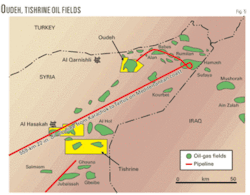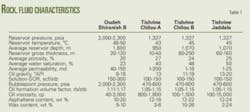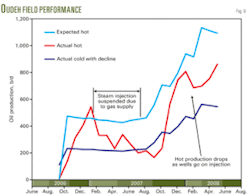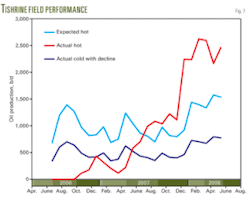To increase oil recovery from existing fields, operators in both Egypt and Syria have started producing heavy oil with thermal enhanced oil recovery processes.
In Egypt’s Issaran oil field, cyclic-steam stimulation has increased oil production to 4,000 b/d from 50 b/d under primary recovery.
In Syria’s Oudeh and Tishrine oil fields, pilot cyclic-steam stimulation has increased production to about 850 b/d from 550 b/d in Oudeh and about 2,500 b/d from 750 b/d in Tishrine. Each field’s pilot has five 25-MMbtu steam generators. The pilots include 14 wells in Oudeh and 23 wells in Tishrine.
Enhanced oil recovery
Operators are focusing on redeveloping and improving oil recovery from existing oil reservoirs because of increased exploration costs for new oil fields, higher oil prices, and limited opportunity for discovering major high-quality oil reserves.
The general approach for developing an oil field includes:1-3
- Collecting, evaluating, and analyzing geological, reservoir and production data if available.
- Estimating reserves and determining the location of remaining oil.
- Selecting proper techniques for the development plan such as drilling new wells, performing stimulation works, applying secondary or tertiary recovery methods.
- Selecting the best technique for improving the recovery factor.
- Studying the overall economy of the proposed development plan.
Development and depletion strategies depend on the life-cycle of a reservoir. In a new discovery, the plan needs to address how best to develop the field, including well spacing, well trajectory, well planning, configuration, stimulation operations, and recovery scheme. If the reservoir has been depleted by primary means, the plan needs to investigate secondary and tertiary recovery schemes.4-6
Secondary recovery typically involves direct oil displacement with injected water into the oil zone or gas injection gas from above the oil zone.
Waterflooding has generated billions of barrels of additional oil. It is inexpensive and simple to use, but the displacement and sweep efficiencies are low. Additional recovery with secondary recovery methods average 3-10% of the oil-in-place.7
Substantial oil, as much as 60% of the initial oil in place, may remain after secondary recovery because of capillary forces, interfacial tensions, and partial reservoir sweep by injected fluids. This remaining oil is the target for enhanced oil recovery methods.
These methods extract remaining oil through increasing oil mobility by reducing oil viscosity, reducing water mobility by increasing water viscosity, or reducing capillary forces by reducing interfacial tension between the displacing fluid and oil.
Thermal methods are usually suitable for high viscosity oils, while chemical methods are mostly for low to medium viscosity oils.
Remaining oil saturation is perhaps the most critical criterion in selecting the EOR method. The choice also depends on such considerations as depth, oil viscosity, etc.8 Thermal EOR methods are often the best for recovering heavy oil. Thermal methods provide a driving force and heat for reducing oil viscosity and improving its mobility.
Thermal processes
The world contains about 10 trillion bbl of heavy oil resources.9 Egypt has about 3 billion bbl of heavy oil in place with about 40% in the Eastern desert, 3% in the Western desert, 18% in Sinai, and 39% in the Gulf of Suez.10
The recovery factors for the world’s heavy oil vary from a fraction of a percent to 80%, depending on the oil and the reservoir characteristics, as well as the technique used. Heavy oil viscosities vary from 100 to 1,000 cp at reservoir temperature. Heavy crudes typically also contain 3 wt % or more sulfur, 10-30% asphaltenes, and as much as 2,000 ppm of vanadium compounds.9
Cyclic-steam stimulation is one of the most common thermal processes in use. It involves injecting steam and then producing oil for the same well. It is considered an economic oil recovery method that costs about $20/bbl of oil recovered.
Oil recovery factors for cyclic-steam in Cold Lake, Alta., are more than 25%, while in Venezuela recoveries as high as 40% have been noted.9
Continuous steamflooding, much like waterflooding, is a pattern drive, with arrays of injection and production wells. In this case, the recovery factor largely depends on the pattern size, since heat loss to the surrounding rocks can consume a large proportion of the injected heat. Oil recovery factors in California with steam injection are about 55% of the initial oil in place.9
Operators seldom employ hot waterflooding because heat losses in surface lines, wellbore, and formation are greater than the heat losses in the other thermal processes. The heat losses reduce the processes effectiveness in decreasing oil viscosity.
In situ combustion oxidizes a portion, about 10%, of the in-place-oil to generate heat. As such, the process has a high thermal efficiency but this process requires more control.
Issaran oil field
A cost-effective development plan with cyclic-steam injection allowed Scimitar Production Egypt Ltd. to improve oil recovery from the Issaran oil field.11 With the process, production rates increased to 4,000 bo/d November 2007 up from 50 bo/d under primary recovery.
The field is 290 km southeast of Cairo and 3 km inland from the western shore of the Gulf of Suez. The Issaran concession has 20,000 acres. General Petroleum Corp. (GPC) Egypt and Scimitar Production Egypt Ltd. started developing the field in 1999.
As of October 2007, Scimitar had drilled 120 wells on the concession.
The major heavy-oil accumulations are within shallow Miocene dolomites and limestones (Upper dolomite, Lower dolomite, and Gharandal and Nukhul limestones), and sandstones (Zeit). Fig. 1 shows the formations present.
The formations contain an oil with a gravity of 10-12°.
In 2003, Scimitar initiated a reservoir engineering study to evaluate enhanced oil recovery (EOR) in the Upper Dolomite of Issaran oil field. It targeted the Upper Dolomite because of its large original oil in place (more than 50% of the concession OOIP) and its low estimated primary recovery of less than 1%.
In 2004, the company conducted a successful cyclic-steam stimulation pilot in well Issaran-44. Initial evaluation indicated that the oil recovery factor from this reservoir could reach 20% compared with about 1% under natural depletion. Fig. 2 compares the simulated and actual results that confirm the pilot’s success.
Based on the pilot, the company decided to begin commercial production. Its redevelopment plan included three phases. Two phases finished in 2007 and the third phase will be finalized in 2008.
The phases involve cyclic-steam stimulation along with seven-spot well patterns (Fig 3). The distance between well is 60 m.
Injection rates start at 1,000 b/d of cold-water equivalent and each cycle lasts for 50 days.
Fig. 4 shows the production of the steamed wells. Production rate fluctuates because of changes in the steam cycles among wells and some problems during the project’s start-up.
Syria fields
Tanganyika Oil Co. Ltd. has implemented cyclic-steam pilots in two giant heavy oil fields, Oudeh and Tishrine, in Syria.12
These fields are in northeast Syria (Fig. 5). Oudeh and Tishrine have an area of 47,500 and 101,000 acres, respectively. The accompanying table shows the reservoir rock and fluid characteristics in these fields.
Development of these fields started in 2004. Initially, a simple sector model evaluated the feasibility of implementing steam injection in the fields. The model considered vertical and high-angle wells.
This model indicated that steam injection would succeed. It showed good results for small 10-acre or less drainage areas and recovery factors of about double of those for cold recovery.
Later, the operator used a more sophisticated sector model to design the pilot project in Oudeh and Tishrine. The black-oil model included a geocellular model for each formation that history matched associated production and pressure data.
All prediction runs considered steam injection at 350° C., 80% steam quality, 1,260 bw/d injection, and maximum 2,030 psia wellhead pressure. The model’s objectives were to:
- Estimate maximum steam injection rates and corresponding heat loss down the wellbore.
- Optimize steam slug size, injection period, and soak time.
- Predict production rates and production cycle length.
- Estimate the optimal well spacing for cyclic steam injection.
- Evaluate the use of horizontal or vertical wells in steamflooding.
- Evaluate the effect of horizontal well length.
Key results indicated a recovery factor of at least double because of the steam, 30-40 days injection cycle yielding the highest recovery factor, 1-3 days soak period, and 120-day production cycle.
By yearend 2005, the company started preparation for the initial pilot plan for cyclic steam stimulation. This pilot placed a 25-MMbtu steam generator in each field and involved two wells in each field. The pilot alternated steam injection and production between the two wells.
Steam injection started in Oudeh in September 2006 and in Tishrine in October 2006. After 4 months of operation in Oudeh, steam injection had to stop for 8 months (February to September 2007) due to excess H2S in the fuel gas.
The pilot projects have expanded with time. Currently, they involve five 25-MMbtu steam generators in each field and 14 wells in Oudeh and 23 wells in Tishrine. Initially, the operator injected steam through the annulus in the first 3 wells of each pilot. Now, all injection goes through vacuum insulated tubing.
Figs. 6 and 7 show the performance of the pilots.
In June 2008, the cyclic steam injection increased production to 850 b/d from about 550 bbl/d in Oudeh and to 2,500 b/d from about 750 bbl/d in Tishrine. Lack of steam injection from February to September 2007 affected Oudeh production.
The steam/oil ratio in this pilot ranges from 1 in the very good wells to 20 in the poorer wells.
Acknowledgment
The authors thank the Financial, Development and Investment (FDI) Holding Co. for contributing to the scientific research at Cairo University, and to Scimitar Production Egypt Ltd. for permission to publish this article.
References
- Babadagli, T., “Mature Field Development—A Review,” Paper No. SPE 93884, SPE European/EAGE Annual Conference, Madrid, June, 13-16, 2005.
- Abu El Ela, M., “Integrated approach recommends redevelopment plan,” OGJ, Aug. 7, 2006, p. 55.
- Abu El Ela, M., “ Data Analysis Methodology for Reservoir Management,” Paper No. SPE 106899, SPE EUROPEC/EAGE Annual Conference and Exhibition, London, June 11-14, 2007.
- Raza, S.H., “Data Acquisition and Analysis for Efficient Reservoir Management,” JPT, April 1992.
- Wiggins, M.L., and Startzman, R.A., “An Approach to Reservoir Management,” Paper No. SPE 20747, SPE ATCE, New Orleans, Sept. 23-26, 1990.
- Satter, Abdus, et al., “Integrated Reservoir Management” Paper No. SPE 22350, SPE International Meeting on Petroleum Engineering, Beijing, Mar. 24-27, 1992.
- Abu El Ela, M., and Mahgoub, I., “Waterflood boosts oil production from field in Egypt,” OGJ, Jan. 7, 2008, p. 43.
- Donaldson, E.C., et al., Enhanced Oil Recovery: Fundamentals and Analysis, New York: Elsevier Science Publishing Co. Inc., 1985.
- Farouq Ali, S.A., et al., Practical Heavy Oil Recovery, draft volume, 1997.
- Oil Potential in Egypt: Statistics & Analysis, EGPC, Sixth Technology Transfer Workshop, SPE Egypt Section, Cairo, May 2007.
- Samir, M., “First Successful Steam Injection Project in Egypt,” IOR Workshop, Sharm El Shaikh, Egypt, June 16-19, 2008.
- Rahoma, A., “Syria Carbonate Steam Projects and Experience,” IOR Workshop, Sharm El Shaikh, Egypt, June 16-19, 2008.
The authors
Mahmoud Abu El Ela ([email protected]) is a lead process engineer at WorleyParsons Engineers Egypt Ltd., and works also as an assistant professor within the Petroleum and Petrochemicals Engineering Consultants (PPEC) Group, Cairo University. He previously was an assistant professor in the petroleum engineering at Cairo University, petroleum process consulting engineer for Khalda Petroleum Co., and a research engineer at Woodside Research Foundation, Curtin University of Technology, Australia. Abu El Ela holds a BSc and an MSc in petroleum engineering from Cairo University, and a PhD from Curtin University of Technology. He is a member of the Egyptian Engineers Syndicate and SPE.
Mohamed Samir ([email protected]) is with Scimitar Production Egypt Ltd. He previously worked for Petrobel in Egypt and ADCO in Abu Dhabi. Samir holds a BSc in petroleum engineering from Suez Canal University and an MSc and a PhD from Cairo University. He is a member of the Egyptian Engineers Syndicate and SPE.
Helmy Sayyouh ([email protected]) is a professor in the petroleum engineering department, Cairo University and also works as a professor within PPEC Group, Cairo University. Since 1986, he has been a consultant engineer in petroleum reservoir engineering, enhanced oil recovery, reservoir simulation, and natural gas engineering. Sayyouh has a BSc and an MS in petroleum engineering from Cairo University and a PhD from Penn State University. Sayyouh is a member of the Egyptian Engineers Syndicate, SPE, and the New York Academy of Science.
Sayed El-Tayeb (sayed_ eltayeb62@ hotmail.com) is a professor in the petroleum engineering department, Cairo University and also works as a professor within the PPEC Group, Cairo University. Since 1998, he has been a consultant engineer in petroleum reservoir engineering and enhanced oil recovery. El-Tayeb holds a BSc and MSc in petroleum engineering from Cairo University and a PhD from Laboratories des Sciences du Genie Chimique, ENSIC Nancy University, France. He is a member of the Egyptian Engineers Syndicate and SPE.
